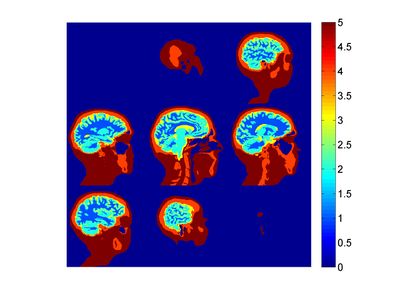Difference between revisions of "MGH Angel 001 voxels"
Jump to navigation
Jump to search
| (6 intermediate revisions by the same user not shown) | |||
| Line 1: | Line 1: | ||
| + | [[File:Angel001.jpeg | 400px|thumb|Segmented "Angel 001" MGH head model ]] | ||
| + | |||
=== Citation === | === Citation === | ||
| − | + | Torrado‐Carvajal A, Herraiz JL, Hernandez‐Tamames JA, Jose‐Estepar S, Eryaman Y, Rozenholc Y, Adalsteinsson E, Wald LL, Malpica N (2015). "[http://onlinelibrary.wiley.com/doi/10.1002/mrm.25737/abstract?userIsAuthenticated=false&deniedAccessCustomisedMessage= Multi‐atlas and label fusion approach for patient‐specific MRI based skull estimation.]" Magnetic Resonance in Medicine. DOI: 10.1002/mrm.25737 | |
=== Download files === | === Download files === | ||
| − | Download the | + | Download the Matlab file containing the segmented volume and the tissue key [https://phantoms.martinos.org/images/2/2f/Angel001_VOXEL.zip here]. |
=== Phantom description === | === Phantom description === | ||
| − | This phantom | + | This phantom is a segmentation of a 1 mm isotropic MPRAGE acquisition of a healthy male into 6 tissue classes: |
| − | + | *Air | |
| − | + | *White matter | |
| − | + | *Grey matter | |
| − | + | *CSF | |
| − | + | *Skull | |
| − | + | *"Average" soft tissues | |
| − | |||
| − | |||
| − | |||
| − | * | ||
| − | * | ||
| − | * | ||
| − | |||
| − | |||
| − | |||
| − | |||
| − | |||
Latest revision as of 13:04, 18 March 2016
Citation
Torrado‐Carvajal A, Herraiz JL, Hernandez‐Tamames JA, Jose‐Estepar S, Eryaman Y, Rozenholc Y, Adalsteinsson E, Wald LL, Malpica N (2015). "Multi‐atlas and label fusion approach for patient‐specific MRI based skull estimation." Magnetic Resonance in Medicine. DOI: 10.1002/mrm.25737
Download files
Download the Matlab file containing the segmented volume and the tissue key here.
Phantom description
This phantom is a segmentation of a 1 mm isotropic MPRAGE acquisition of a healthy male into 6 tissue classes:
- Air
- White matter
- Grey matter
- CSF
- Skull
- "Average" soft tissues
